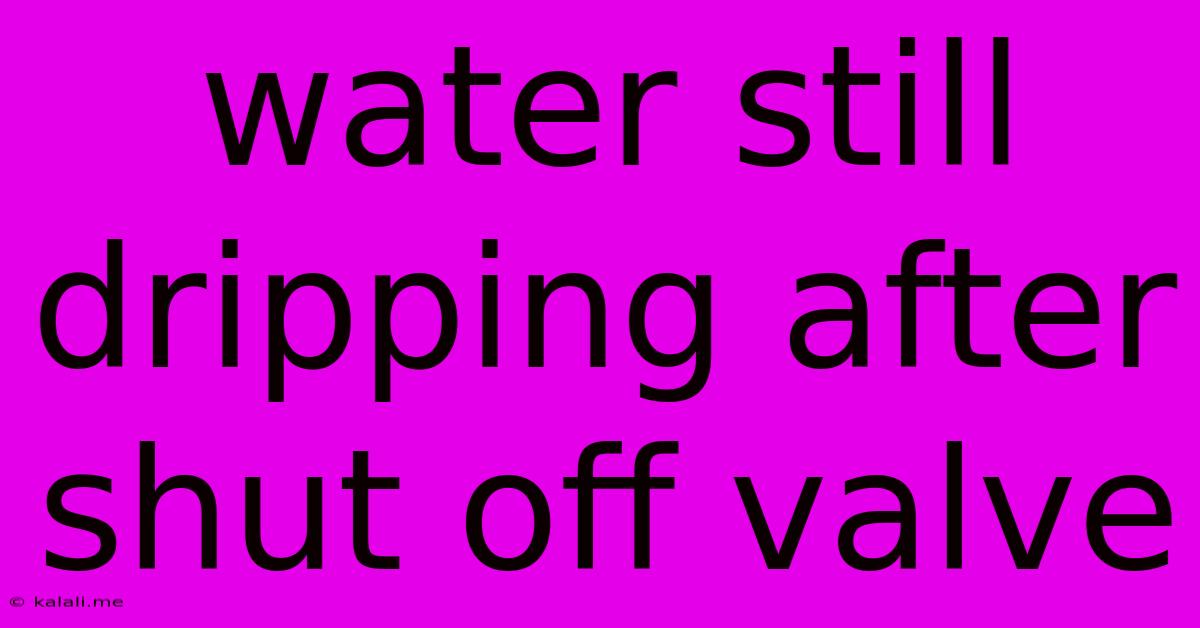Water Still Dripping After Shut Off Valve
Kalali
Jun 08, 2025 · 3 min read

Table of Contents
Water Still Dripping After Shut Off Valve: Troubleshooting and Solutions
Meta Description: Dealing with a persistent drip after turning off your water valve? This guide explores common causes, from simple fixes like tightening the valve to more complex issues like internal valve damage. Learn how to troubleshoot and resolve this annoying problem.
A persistent drip from a faucet after you've shut off the valve is more than just annoying; it's a waste of water and potentially a sign of a bigger plumbing problem. The good news is that in many cases, you can solve this yourself with some basic troubleshooting. This article will guide you through the common causes and solutions to get that drip to stop.
Identifying the Source of the Drip
Before you start wrenching, it's crucial to pinpoint exactly where the water is coming from. Is it dripping from the faucet spout, the handle, or the valve itself? This will help narrow down the potential problems.
Common Causes and Solutions
Here's a breakdown of the most frequent culprits behind that persistent drip, along with practical solutions:
1. Loose or Worn-Out Washer:
- Symptom: A slow, steady drip from the faucet spout.
- Cause: The washer at the base of the faucet stem might be worn, loose, or improperly seated. This is a common issue in compression faucets.
- Solution: This is often an easy DIY fix. You'll need to turn off the water supply, remove the handle, and replace the worn washer with a new one. Plenty of tutorials are available online showing how to replace faucet washers for various faucet types (e.g., single handle, two handle). Remember to match the size and type of washer to your faucet model.
2. Sediment Buildup:
- Symptom: A slow drip, potentially with some sputtering or irregular dripping.
- Cause: Mineral deposits or sediment can build up inside the valve, hindering its ability to seal properly. This is more common in areas with hard water.
- Solution: Try flushing the valve by turning the water supply fully on for a few minutes, then off. Repeat this several times. You might also consider using a commercial descaling solution (follow product instructions carefully). If the problem persists, a thorough cleaning or valve replacement might be necessary.
3. Damaged O-Rings or Seals:
- Symptom: A persistent drip from around the valve stem or handle.
- Cause: The O-rings or seals within the faucet mechanism may be worn, cracked, or damaged, preventing a proper seal.
- Solution: Replacing these seals often requires disassembling the faucet. You'll need to find replacement O-rings that are compatible with your faucet model.
4. Faulty Valve:
- Symptom: A steady drip that doesn't improve after attempting other solutions.
- Cause: The internal components of the valve itself might be damaged or worn out beyond repair.
- Solution: Unfortunately, this usually necessitates replacing the entire valve. This can be a more involved process and might require the expertise of a plumber, especially for shut-off valves located within walls.
5. High Water Pressure:
- Symptom: Dripping from various points, not necessarily just the shut-off valve.
- Cause: Excessive water pressure can overwhelm even a properly functioning valve, leading to leaks.
- Solution: Consider installing a pressure regulator to reduce water pressure throughout your home.
6. Simply Tighten the Valve Handle:
- Symptom: A minor drip that might be easily resolved.
- Cause: Sometimes, a slightly loose valve handle is the culprit. A little tightening can be enough to resolve the problem.
- Solution: Try tightening the valve handle slightly using an appropriate wrench.
When to Call a Plumber
If you've tried the above solutions and the dripping continues, or if you're uncomfortable working with plumbing, it's best to call a qualified plumber. A persistent leak can lead to water damage and higher water bills, making professional help a worthwhile investment. They have the tools and expertise to diagnose and fix more complex problems. Remember to always turn off the main water supply before undertaking any major plumbing repairs.
Latest Posts
Latest Posts
-
Reduce Preload On Bolts In Shear
Jun 09, 2025
-
How To Stop Reels On Facebook
Jun 09, 2025
-
Random Walk As The Sum Errors
Jun 09, 2025
-
Is There A Such Thing As
Jun 09, 2025
-
Verses That Show That There Is Little Time Left
Jun 09, 2025
Related Post
Thank you for visiting our website which covers about Water Still Dripping After Shut Off Valve . We hope the information provided has been useful to you. Feel free to contact us if you have any questions or need further assistance. See you next time and don't miss to bookmark.